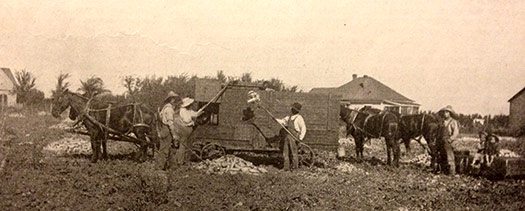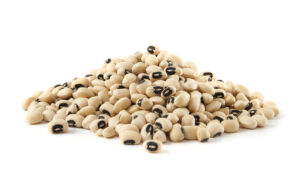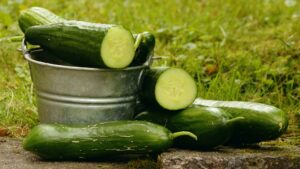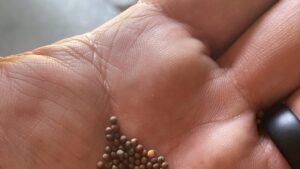A MOMENT IN TIME:
In this article from Seed World’s first year of publication nearly a century ago, the process of harvesting cucumber and muskmelon seed is detailed.

FACTS AND FIGURES FROM
THIS 1915 ISSUE:
$2 is the amount it cost for an annual subscription to Seed World.
$20,000 is the estimated loss to the Hardin, Hamilton & Lewman seed company after its seed house in Louisville, Kentucky, was completely destroyed by a fire on April 1, 1915.
$1 is the average cost per bushel for bluegrass seed in the United States.
980,185 pounds of alfalfa seed are imported through New York’s ports, just in February.
850 pounds per acre is the yield of cucumber seed from this field of White Spine cucumber in Fremont, Nebraska.
Cucumber and melon Seed Harvest
Nebraska has, for a number of years, supplied to the trade a number of great quantities of the seeds of melons, cucumber, squash, field and sweet corn.
Thousands of acres are owned and farmed by seed growers and thousands more are grown for them on contract. The climate and soil of Nebraska seem to be particularly adapted for the growing of these seed crops.
When the cucumber crop is ready for harvest, a special thrashing machine, drawn by two horses, is taken into the field. This machine consists of a large hopper into which the cucumbers are forked. Inside of the hoppers are two cylinders, one running at a slow speed and the other fast, which crushes the cucumbers. The crushed rinds, seeds and juice go from the crushing cylinders to a revolving reel, which is covered with a wire screen.
The revolving reel carries the rinds and pulp up to the top from which they drop to the bottom and jar out any seed that may be sticking to them. The rinds go out at the end of the reel on a pile.
The seed and juice go into a tank beneath the reel and are drawn off into a sled box. The seed and juice are then hauled to a tank set down in the ground, into which they are discharged and allowed to remain from four to six days to ferment, being stirred with a rake every day to keep them from crusting over and becoming dry on the top. During this period it is very important that no water be added or rain allowed to fall into the tank and this is followed by an excessive fermentation, which is apt to ruin the seed.
After they are sufficiently fermented, they are taken to a wooden trough with a screen bottom where they are washed in running water. The good seed sinks to the bottom of the screened box and the light seed, rinds and pulp float on the top and go down the stream.
This is sometimes accomplished by carrying seeds through a sort of sluice, divided by dams, three or four in number, each one a little higher than the one below it. The pulp and seeds are shoveled into the upper section, a continuous stream of water washes the pulp over the dams and the seeds settle into each compartment and are taken out with a scoop shovel.
The clean seeds are then sacked and hauled to the drying sheds where they are spread on racks three feet wide and 12 feet long and exposed to the sun and wind during the day and carried into the sheds at night. A few days of clear sunny weather is sufficient to dry the seeds when they are ready to go to the warehouse to be cleaned and polished.
In harvesting cantaloupes, the seed is scraped into buckets by hand. The rinds are thrown aside and left to decay or sometimes fed to horses and cattle.
The seed is emptied into barrels and allowed to ferment the same as cucumber, and after fermenting the washing and drying process is the same as for cucumber. The average yield of melon seed is from three to four hundred and fifty pounds to an acre.
Wisconsin Peas
It has been too dry for pea growers in the Wisconsin territory. There is much complaint about not being able to work the soil. It will take some good rains to put the land in condition for sowing. In all probability the U.S. will need a good-sized crop to supply the demand. If Germany does not have a crop, it throws the source of supply on America and New Zealand. England would have to look to these countries for their requirements.
Field Peas v. Cow Peas
A great deal of inquiry comes to the Agricultural College in regard to cow peas. It may be well to call attention to the difference between cow peas and field peas. Cow peas are really beans. Cow peas is a crop grown in the South. It requires a hot climate for development. It will not thrive in cool weather and the least frost kills it.
Field peas are true peas and will stand a great deal of cold. They are not injured by slight frosts. They grow better in cool climates where the days are relatively cool and the nights are quite cool. Cow peas are not adapted for Colorado conditions. In fact, they can only be grown in a few of the warmer portions of the state. Field peas, however, are excellent for our high Colorado altitudes and cooler situations. — Alvin Keyser, Colorado Experiment Station, Fort Collins, Colorado















